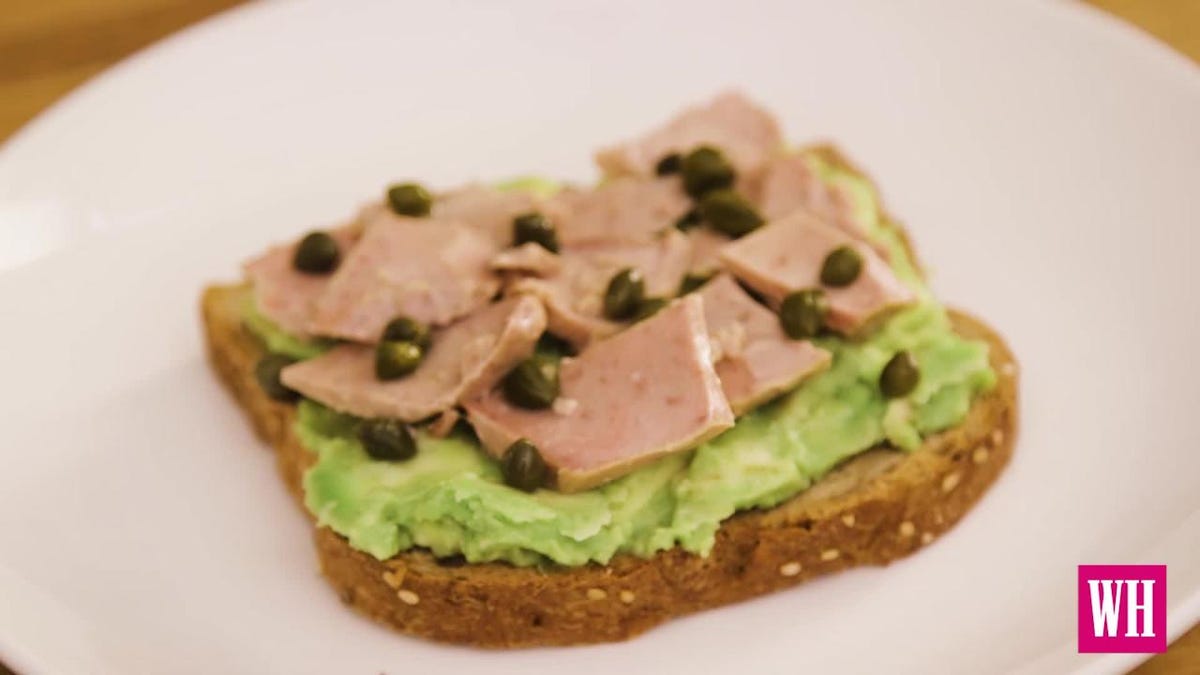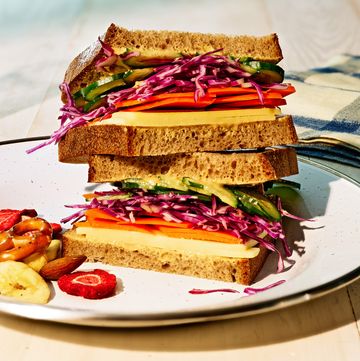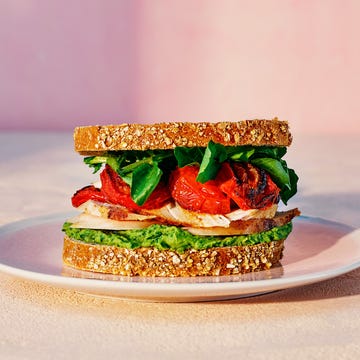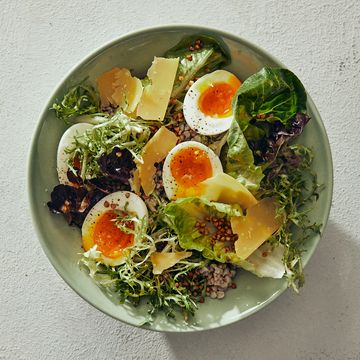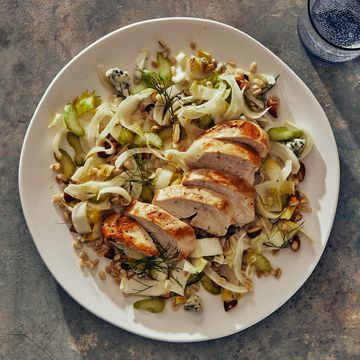Here’s food trivia you probably haven’t heard before: There are at least eight different varieties of avocado that are in season at different times of the year. About 90 percent of avocados grown in the U.S. come from California; the rest are from Florida. That said, only 10 percent of avocados sold in the U.S. are grown here—down from 85 percent in the 1980s—as more than ever are imported from Mexico as well as Chile, Peru, and the Dominican Republic, says Jan DeLyser, VP Marketing for the California Avocado Commission. Here’s a breakdown of the varieties, when they’re grown, and where to find them—along with all the ways to prepare and use them.
(Cooling down and getting healthy is easy with the recipes from Simple Green Smoothies, available at the Women's Health Boutique!)
Avocados you can find nationwide
Three varieties—Hass, Lamb Hass, and Reed—are the only types of avocados you’ll see outside of California in stores around the country.
Hass avocado
In California, Hass makes up 95 percent of the avocado crop; most imported avocados are Hass, too. “People who are buying avocados are really only buying Hass varieties,” says DeLyser. Hass avocados have an oval shape and a thick, pebbled skin that makes it the easiest variety to peel. The skin changes from green to purplish-black as it ripens. It’s got a medium-small seed and pale green flesh with a creamy texture and a dense, creamy, nutty flavor. It varies in size from five to 12 ounces. While you can find Hass avocados year-round, California avocados are best between February and October.
Lamb Hass avocado
The Lamb Hass is a derivative of the Hass that’s very similar in flavor and appearance but bigger, weighing in at 11.75 ounces to 18.75 ounces. It’s also carried throughout the country—though you may not know you’re buying one because many retailers label it simply Hass, says DeLyser. The best way to tell the difference, besides the size, is the stem: Hass avocado stems sit to the side, while Lamb Hass stems are almost dead-center. It’s best eaten June through October.
Reed avocado
While Reed avocados aren’t as widely available as Hass varieties, “they have a very good flavor. We’re seeing more Reeds planted because people recognize them and they’re popular,” says DeLyser. These fruits have a distinct round shape and weigh anywhere from eight to 18 ounces. The thick, green, slightly pebbly skin remains green as it ripens and has a more watery flesh than the Hass. Find Reed avocados from July to October in farmer’s markets and some supermarkets nationwide—though the crop this year was lighter, so they may be a bit harder to track down, DeLyser says.
RELATED: 5 Ways to Use Up That Bowl of Overripe Fruit on Your Counter
“Heritage” avocado varieties
The five other main breeds of avocados—Bacon, Fuerte, Gwen, Pinkerton, and Zutano—are “heritage varieties” because they’re not widely sold and are grown mostly as cross-pollinators to help keep Hass avocado trees healthy. “The volume is really light, so you’ll really only see them in farmer’s markets in California,” DeLyser says. All varieties have a thinner skin that’s a bit tougher to peel and remains green as it ripens. A green fruit’s flesh is more water-based than the Hass, and tends to taste less dense and oily.
Fuerte avocado
In the 1980s, the Fuerte was the main avocado grown in California. “The reason the Hass surpassed it is because, like most green-skinned varieties, it doesn’t ship as well,” says DeLyser. “But people in California still love the flavor.” These avocados have a pear shape, a medium seed, and a thin, smooth skin that stays green as it ripens. They vary in size, from five to 14 ounces, and the flesh is creamy and pale green with a mild flavor. Find them from November to February.
Pinkerton avocado
For a while in the early 2000s, you could also find Pinkertons in stores nationwide—but, like the Fuertes, they have a thinner green skin that doesn’t ship as well as the Hass. “They come in larger sizes and the flavor is good, but now it’s rare to find them outside of California,” DeLyser says. Long and pear-shaped, this avocado has a very small seed and a medium-thick, slightly pebbly green skin that deepens in color as it ripens. It weighs eight to 18 ounces and is in season from November to February.
Gwen avocado
With a slightly nutty taste and texture similar to Hass avocados, the Gwen has a plump, oval shape and green, pebbly, thick skin that dulls as it ripens. It weighs anywhere from six to 15 ounces and is in season February to June. It is only found in California farmer’s markets.
Bacon avocado
No, they're not bacon flavored. These avocados have a smooth green skin that remains green as it ripens. The fruit, which weighs six to 12 ounces, has an oval shape with a larger seed and a light flavor with a yellow-green flesh. Find them from November to February in California farmer’s markets.
Zutano avocado
“I’ve only seen this variety once, in a Santa Barbara farmer’s market,” says DeLyser. “It’s got the thinnest skin that’s a bit difficult to peel, and it doesn’t ship.” This pear-shaped avocado weighs six to 14 ounces and has a shiny, thin, pale yellow-green skin that keeps the same color as it ripens. It’s in season between September and November.
How to choose the best avocado at the store
Pick an avocado free of bruises and shrivel that feels heavy for its size. The best way to tell if your avocado is ripe is to cradle it in the palm of your hand and bring your fingers together, feeling for give in your palm. “Avoid squeezing with your fingertips because it bruises the fruit,” says DeLyser.
Now that you've got your avocados, try these fun avo toast recipes:
How to store avocados
You're generally okay leaving your avocados out on the counter until you're ready to use them. Speed up ripening by storing avocados in a bag with other fruit (like bananas, apples, or pears). If you already have a super-ripe avocado, you can keep a whole one fresh for up to five days longer by sticking it in the fridge. When it comes to cut avocados, wrap it tightly in plastic wrap (press down the film flat against the exposed flesh of the fruit) or rub the exposed flesh in lemon or lime juice before storing in the fridge to prevent browning.
How to prepare avocados
To remove the fruit from the skin, don’t scoop—you’ll lose some of that nutritional goodness. Instead, cut the fruit in half by slicing through until you hit the pit, then running your knife through the rest of the fruit around the pit. Then twist the two cut halves. “The pit falls right out, and you can peel the skin right back,” says DeLyser.
How to eat avocados
There's tons of ways to enjoy fresh avocados, from guacamole to avocado toast to topping a grain bowl or salad. They're also commonly used as a substitute for butter or dairy fats because of their creamy consistency. Try blending them into a smoothie, adding them into a salad dressing, or hey, even mashing them up and putting them on your face for an easy moisturizing mask.
RELATED: 10 Things To Make With Avocado That Aren't Toast
What is the nutritional value of avocados?
They're superfoods for a reason. The FDA increased the recommended serving size for avocados in 2016 from one-fifth of a fruit to one-third. In one serving, you’ll down 95 calories, mostly from heart-healthy monounsaturated fats along with three grams of fiber, 10 percent of your daily value of folate, and 15 percent of your daily value of vitamin B5. The highest concentration of nutrients on all avocados is the slightly darker green outer layer of flesh just next to the skin, says DeLyser, so make sure not to leave any stuck there.
Limit your intake to no more than half of a fruit per day, due to their high fat concentration. Think of them as a healthy treat!

Colleen de Bellefonds is an American freelance journalist living in Paris, France, with her husband and dog, Mochi. She loves running, yoga, and wine, and is very particular about her baguettes.

